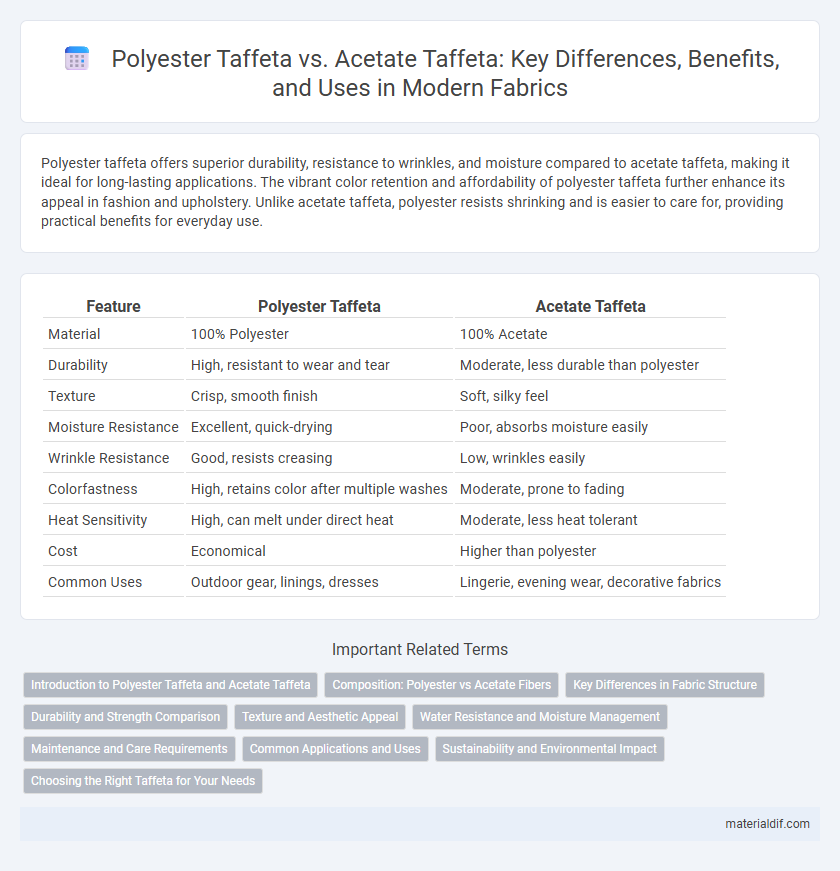Polyester taffeta offers superior durability, resistance to wrinkles, and moisture compared to acetate taffeta, making it ideal for long-lasting applications. The vibrant color retention and affordability of polyester taffeta further enhance its appeal in fashion and upholstery. Unlike acetate taffeta, polyester resists shrinking and is easier to care for, providing practical benefits for everyday use.
Table of Comparison
| Feature | Polyester Taffeta | Acetate Taffeta |
|---|---|---|
| Material | 100% Polyester | 100% Acetate |
| Durability | High, resistant to wear and tear | Moderate, less durable than polyester |
| Texture | Crisp, smooth finish | Soft, silky feel |
| Moisture Resistance | Excellent, quick-drying | Poor, absorbs moisture easily |
| Wrinkle Resistance | Good, resists creasing | Low, wrinkles easily |
| Colorfastness | High, retains color after multiple washes | Moderate, prone to fading |
| Heat Sensitivity | High, can melt under direct heat | Moderate, less heat tolerant |
| Cost | Economical | Higher than polyester |
| Common Uses | Outdoor gear, linings, dresses | Lingerie, evening wear, decorative fabrics |
Introduction to Polyester Taffeta and Acetate Taffeta
Polyester taffeta is a durable, lightweight fabric known for its smooth, crisp texture and excellent wrinkle resistance, commonly used in linings and activewear. Acetate taffeta, derived from cellulose fibers, offers a glossy finish and luxurious feel but is less durable and more prone to moisture damage compared to polyester. Both fabrics share a tightly woven construction typical of taffeta, yet polyester excels in strength and versatility, while acetate prioritizes sheen and softness.
Composition: Polyester vs Acetate Fibers
Polyester taffeta is composed of synthetic polyester fibers known for high durability, wrinkle resistance, and moisture-wicking properties, making it ideal for outerwear and linings. Acetate taffeta consists of cellulose acetate fibers derived from wood pulp, offering a smooth, lustrous finish with excellent drape but lower durability and heat resistance compared to polyester. The fiber composition significantly impacts fabric performance, with polyester providing greater strength and longevity, while acetate delivers superior sheen and comfort.
Key Differences in Fabric Structure
Polyester taffeta features a synthetic fiber composition that enhances durability, water resistance, and wrinkle recovery, while acetate taffeta is made from cellulose acetate fibers, offering a luxurious sheen and a smoother, silk-like feel. The weave of polyester taffeta tends to be tighter, contributing to its strength and matte finish, whereas acetate taffeta exhibits a softer drape with a more lustrous surface due to its fiber structure. These fabric structure differences affect performance characteristics such as breathability, colorfastness, and suitability for applications like linings, evening wear, and accessories.
Durability and Strength Comparison
Polyester taffeta exhibits superior durability and tensile strength compared to acetate taffeta, making it more resistant to wear and tear in high-stress applications. The synthetic nature of polyester fibers grants enhanced resistance to stretching, shrinking, and abrasion, while acetate taffeta tends to weaken faster under prolonged friction and exposure to moisture. This makes polyester taffeta the preferred choice for garments and upholstery demanding long-lasting performance and structural integrity.
Texture and Aesthetic Appeal
Polyester taffeta features a smooth, crisp texture with a subtle sheen that offers durability and resistance to wrinkles, making it ideal for structured garments and linings. Acetate taffeta provides a softer, silkier feel with a more lustrous finish, enhancing its aesthetic appeal for elegant eveningwear and drapery. The choice between polyester and acetate taffeta depends on the desired balance between texture resilience and luxurious appearance.
Water Resistance and Moisture Management
Polyester taffeta offers superior water resistance due to its hydrophobic fibers, making it less prone to absorbing moisture and ideal for outdoor and rainwear applications. Acetate taffeta, while smooth and lightweight, lacks the same level of water resistance and tends to absorb moisture more readily, reducing its effectiveness in wet conditions. Polyester's enhanced moisture-wicking properties also improve breathability and comfort by efficiently managing sweat and humidity.
Maintenance and Care Requirements
Polyester taffeta requires minimal maintenance due to its high durability, wrinkle resistance, and resistance to water and stains, allowing for easy machine washing and quick drying. Acetate taffeta demands more delicate care, often requiring dry cleaning and gentle hand washing to avoid damage, as it is prone to shrinking and color fading when exposed to heat or moisture. Choosing polyester taffeta ensures long-lasting fabric quality with less effort in upkeep, whereas acetate taffeta needs careful handling to maintain its sheen and texture.
Common Applications and Uses
Polyester taffeta is widely used in outdoor gear, linings, and home furnishings due to its durability, water resistance, and ease of care. Acetate taffeta is preferred for luxurious lining fabrics, formalwear, and evening gowns, providing a smooth, lustrous finish with a softer hand feel. Both fabrics serve distinct purposes based on their performance characteristics, with polyester excelling in practical applications and acetate favored for high-end fashion.
Sustainability and Environmental Impact
Polyester taffeta, derived from synthetic polymers, tends to have a higher environmental footprint due to its reliance on petrochemicals and non-biodegradability, contributing to microplastic pollution. In contrast, acetate taffeta, while also synthetic, is partially biodegradable and often made from cellulose acetate, offering a slightly more sustainable option though it still involves chemical processing. Both materials present sustainability challenges, but acetate taffeta generally poses a lower long-term environmental impact compared to polyester taffeta.
Choosing the Right Taffeta for Your Needs
Polyester taffeta offers durability, wrinkle resistance, and affordability, making it ideal for everyday wear and industrial applications. Acetate taffeta provides a luxurious sheen and excellent drape, suitable for formal garments and high-end fashion. Selecting the right taffeta depends on prioritizing resilience and ease of care versus elegance and softness.
Polyester Taffeta vs Acetate Taffeta Infographic

 materialdif.com
materialdif.com